Biodiversity Enhancement for Improving the Sustainability of Broccoli (Brassica oleracea vr. italica Plenk) Organic Seed Production
Abstract
:1. Introduction
- From a technical point of view, to verify what are the optimal growing conditions needed to pursue good yields and high-quality organic seed with the use of new organic low-input tools for plant nutrition;
- From the socio-economic point of view, to identify the factors that condition entrepreneurial behaviour according to the production choice linked to biodiversity, the characteristics and the market for the supply of seeds and the placement of the final product.
2. Materials and Methods
2.1. General Organization of Research
2.2. Socio-Economic Analysis of Horticultural Biodiversity
- β0= intercept;
- β1= inclination of Y with respect to the variable X1, holding constant the variables X2, X3, …, Xp;
- βp = inclination of Y with respect to the variable Xp holding constant the variables X2, X3, …, Xp-1;
- εi = at observation i.
- Is there, based on the independent variables found, a good model able to explain entrepreneurial behaviour in the choice of broccoli biodiversity?
- What is the importance of territorial location, market aspects, production orientation, cultivation practices inspired by sustainability and access to the seed market in predicting the use of landraces of broccoli?
- How do sensitivity to sustainability, openness to the market and the ability to build a supply chain influence the quality of broccoli seed self-produced by growers?
2.3. Low Input and High Quality Organic Seed Production
3. Results
3.1. Characteristics of the Farms Surveyed
3.2. Factors Affecting Seed Production of Quality Biodiversity
- Is there, based on the independent variables, a good model capable of explaining the diversity of behaviours existing between the different realities surveyed?
- What importance do the selected variables have on the choice of the broccoli biodiversity to be cultivated and on the related seed market?
- How does the use of mass selection guarantee the opportunity to multiply the seed and maintain the patrimonial value of biodiversity?
3.3. Broccoli Seed Production and Its Sustainability Levels
4. Conclusions
- The good combination of broccoli biodiversity and organic farming;
- The regeneration or self-reproduction of seeds by the farmer is interesting because it is stable and adequately productive.
Author Contributions
Funding
Institutional Review Board Statement
Informed Consent Statement
Data Availability Statement
Conflicts of Interest
References
- Ten Kate, K.; Laird, S.A. The Commercial Use of Biodiversity: Access to Genetic Resources and Benefit-Sharing; Earthscan: London, UK, 1999. [Google Scholar]
- Kotschi, J.; Wirz, J. Who Pays for Seeds? Thoughts Financ. Org. Plant 2015, 5, 13. [Google Scholar]
- Conversa, G.; Lazzizera, C.; Bonasia, A.; Cifarelli, S.; Losavio, F.; Sonnante, G.; Elia, A. Exploring on-farm agro-biodiversity: A study case of vegetable landraces from Puglia region (Italy). Biodivers. Conserv. 2020, 29, 747–770. [Google Scholar] [CrossRef]
- Lutaladio, N.; Burlingame, B.; Crews, J. Horticulture, biodiversity and nutrition. J. Food Compos. Anal. 2010, 23, 481. [Google Scholar] [CrossRef]
- Ceroni, M.; Liu, S.; Costanza, R. Ecological and Economic Roles of Biodiversity in Agroecosystems. Manag. Biodivers. Agric. Ecosyst. 2007, 13, 446–472. [Google Scholar]
- Wang, J.F.; Dinssa, F.F.; Ebert, A.W.; Hughes, J.D.; Stoilova, T.; Nenguwo, N.; Dhillon, N.P.S.; Easdown, W.J.; Mavlyanova, R.; Tenkouano, A.; et al. Indigenous vegetables worldwide: Their importance and future development. In Proceedings of the XXIX International Horticultural Congress on Horticulture: Sustaining Lives, Livelihoods and Landscapes (IHC2014), Brisbane, Australia, 25 August 2014; pp. 1–20. [Google Scholar]
- Lipper, L.; Dalton, T.J.; Anderson, C.L.; Keleman, A. Agricultural markets and the sustainable utilization of crop genetic resources. In Seed Trade in Rural Markets; Routledge: London, UK, 2009; pp. 23–34. [Google Scholar]
- Lipper, L.; Anderson, C.L.; Dalton, T.J. (Eds.) Seed Trade in Rural Markets: Implications for Crop Diversity and Agricultural Development; Earthscan: London, UK, 2010. [Google Scholar]
- Salazar, L.; Winters, P. The impact of seed market access and transaction costs on potato biodiversity and yields in Bolivia. Environ. Dev. Econ. 2012, 17, 633–661. [Google Scholar] [CrossRef]
- Branca, F. Cauliflower and broccoli. In Vegetables I; Springer: New York, NY, USA, 2008; pp. 151–186. [Google Scholar]
- Wildfong, B.; Bocking, S. The Chain of Seeds: Biodiversity and Agriculture. In Biodiversity in Canada; University of Toronto Press: Toronto, ON, Canada, 2019; pp. 137–145. [Google Scholar]
- Santilli, J. Law, Policy and Agricultural Biodiversity. In Routledge Handbook of Agricultural Biodiversity; Routledge: London, UK, 2017; pp. 419–434. [Google Scholar]
- Frison, C. Redesigning the Global Seed Commons. Law and Policy for Agrobiodiversity and Food Security; Routledge: London, UK, 2018. [Google Scholar]
- Senini, E. Farm Saved Seeds: A Right to Use or a Right Abused. Eur. Food Feed L Rev. 2018, 13, 116. [Google Scholar]
- Ten Kate, K. Horticulture. In The Commercial Use of Biodiversity; Routledge: London, UK, 2019; pp. 158–187. [Google Scholar]
- Visser, B. An agrobiodiversity perspective on seed policies. J. New Seeds 2002, 4, 231–245. [Google Scholar] [CrossRef]
- Padulosi, S.; Sthapit, B.; Lamers, H.; Kennedy, G.; Hunter, D. Horticultural biodiversity to attain sustainable food and nutrition security. In Proceedings of the International Symposia on Tropical and Temperate Horticulture-ISTTH2016 1205, Cairns, Australia, 20–25 November 2016; pp. 21–34. [Google Scholar]
- Timpanaro, G.; Foti, V.T. Innovation and the role of social capital in nursery industry: The case of Sicilian micropropagation companies. Agric. Econ. Rev. 2016, 17, 34–49. [Google Scholar]
- Gauchan, D.; Shrestha, R.B. Community Based Seed Systems for Agrobiodiversity and Resilient Farming of Smallholder Agriculture in South Asia. In Strengthening Seed Systems-Promoting Community Based Seed Systems for Biodiversity Conservation and Food & Nutrition Security in South Asia; SAARC Agriculture Centre (SAC): Dhaka, Bangladesh; Asian Farmers’ Association (AFA): Quezon City, Philippines; Pakistan Agricultural Research Council (PARC): Islamabad, Pakistan, 2020; pp. 29–53. [Google Scholar]
- Foti, V.T.; Scuderi, A.; Timpanaro, G. Organic Social Agriculture: A Tool for Rural Development. Calitatea 2013, 14, 266. [Google Scholar]
- Barbieri, P.; Bocchi, S. Analysis of the alternative agriculture’s seeds market sector: History and development. J. Agric. Environ. Ethics 2015, 28, 789–801. [Google Scholar] [CrossRef]
- Stolze, M.; Sanders, J.; Kasperczyk, N.; Madsen, G.; Meredith, S. CAP 2014–2020: Organic Farming and the Prospects for Stimulating Public Goods; IFOAM EU: Brussels, Belgium, 2016. [Google Scholar]
- Döring, T.F.; Bocci, R.; Hitchings, R.; Howlett, S.; Lammerts van Bueren, E.T.; Pautasso, M.; Raaijmakers, M.; Rey, F.; Stubsgaard, A.; Wolfe, M.S.; et al. The organic seed regulations framework in Europe. Current status and recommendations for future development. Org. Agric. 2012, 2, 173–183. [Google Scholar]
- Timpanaro, G.; Bellia, C.; Foti, V.T. Horticultural agro-biodiversity and potential conservation: Case study in Sicily. Calitatea 2014, 15, 230. [Google Scholar]
- Elia, A.; Santamaria, P. Biodiversity in vegetable crops, a heritage to save: The case of Puglia region. Ital. J. Agron. 2013, 15, e4. [Google Scholar] [CrossRef] [Green Version]
- Ordiales, E.; Iglesias, D.J.; Alarcón, M.V.; Zajara, L.; Gil, J.; Gutiérrez, J.I.; Salguero, J. Characteristics defining broccoli cultivars from different seed producers. Int. J. Agron. 2017, 2017, 8216390. [Google Scholar] [CrossRef] [Green Version]
- Branca, F.; Chiarenza, G.L.; Cavallaro, C.; Gu, H.; Zhao, Z.; Tribulato, A. Diversity of Sicilian broccoli (Brassica olercea var. italica) and cauliflower (Brassica oleracea var. botrytis) landraces and their distinctive bio.morphological, antioxidant and genetic traits. Genet. Resour. Crop Evol. 2018, 65, 485–502. [Google Scholar] [CrossRef]
- Ciancaleoni, S.; Chiarenza, G.L.; Raggi, L.; Branca, F.; Negri, V. Diversity characterization of broccoli (Brassica oleracea L. var. italiaca Plenk) landraces for their on farm (in situ) safeguard and use in breeding programs. Genet. Resour. Crop Evol. 2014, 61, 451–464. [Google Scholar] [CrossRef]
- Timpanaro, G.; Urso, A.; Prato, C.; Foti, V.T. Evaluating the potential for development of vegetable nursery industry: Analysis in an important vegetable region in Italy. Am. J. Agric. Biol. Sci. 2015, 10, 74–82. [Google Scholar] [CrossRef] [Green Version]
- Timpanaro, G.; Urso, A.; Foti, V.T. Technical and scale efficiency in nursery enterprises in an area of significant widespread horticulture in Italy. HortScience 2018, 53, 208–216. [Google Scholar] [CrossRef]
- Timpanaro, G.; Scuderi, A.; Foti, V.T. A network for the conservation of agrobiodiversity of local ecotypes. Acta Hortic. 2016, 1142, 163–169. [Google Scholar] [CrossRef]
- Foti, V.T.; Scuderi, A.; Stella, G.; Timpanaro, G. Consumer purchasing behaviour for “biodiversity-friendly” vegetable products: Increasing importance of informal relationships. Agric. Econ. 2019, 65, 404–414. [Google Scholar] [CrossRef] [Green Version]
- Williams, E.R.; Matheson, A.C.; Harwood, C.E. Experimental Design and Analysis for Tree Improvement; CSIRO Publishing: Clayton, Australia, 2002. [Google Scholar]
- Teasdale, J.R.; Mangum, R.W.; Radhakrishnan, J.; Cavigelli, M.A. Weed seedbank dynamics in three organic farming crop rotations. Agron. J. 2004, 96, 1429–1435. [Google Scholar] [CrossRef]
- Fusaro, S.; Squartini, A.; Paoletti, M.G. Functional biodiversity, environmental sustainability and crop nutritional properties: A case study of horticultural crops in north-eastern Italy. Appl. Soil Ecol. 2018, 123, 699–708. [Google Scholar] [CrossRef]
- Kumar, A. Role of horticulture in biodiversity conservation. In Sustainable Horticultural Systems; Springer: Cham, Switzerland, 2014; pp. 143–155. [Google Scholar]
- Laird, S.A.; Wynberg, R.; Laird, S.A. Institutional policies for biodiversity research. In Biodiversity and Traditional Knowledge, Equitable Partnerships in Practice; Earthscan Publications Ltd.: London, UK, 2002; pp. 39–76. [Google Scholar]
- Samuels, J. Biodiversity of food species of the Solanaceae family: A preliminary taxonomic inventory of subfamily Solanoideae. Resources 2015, 4, 277–322. [Google Scholar] [CrossRef] [Green Version]
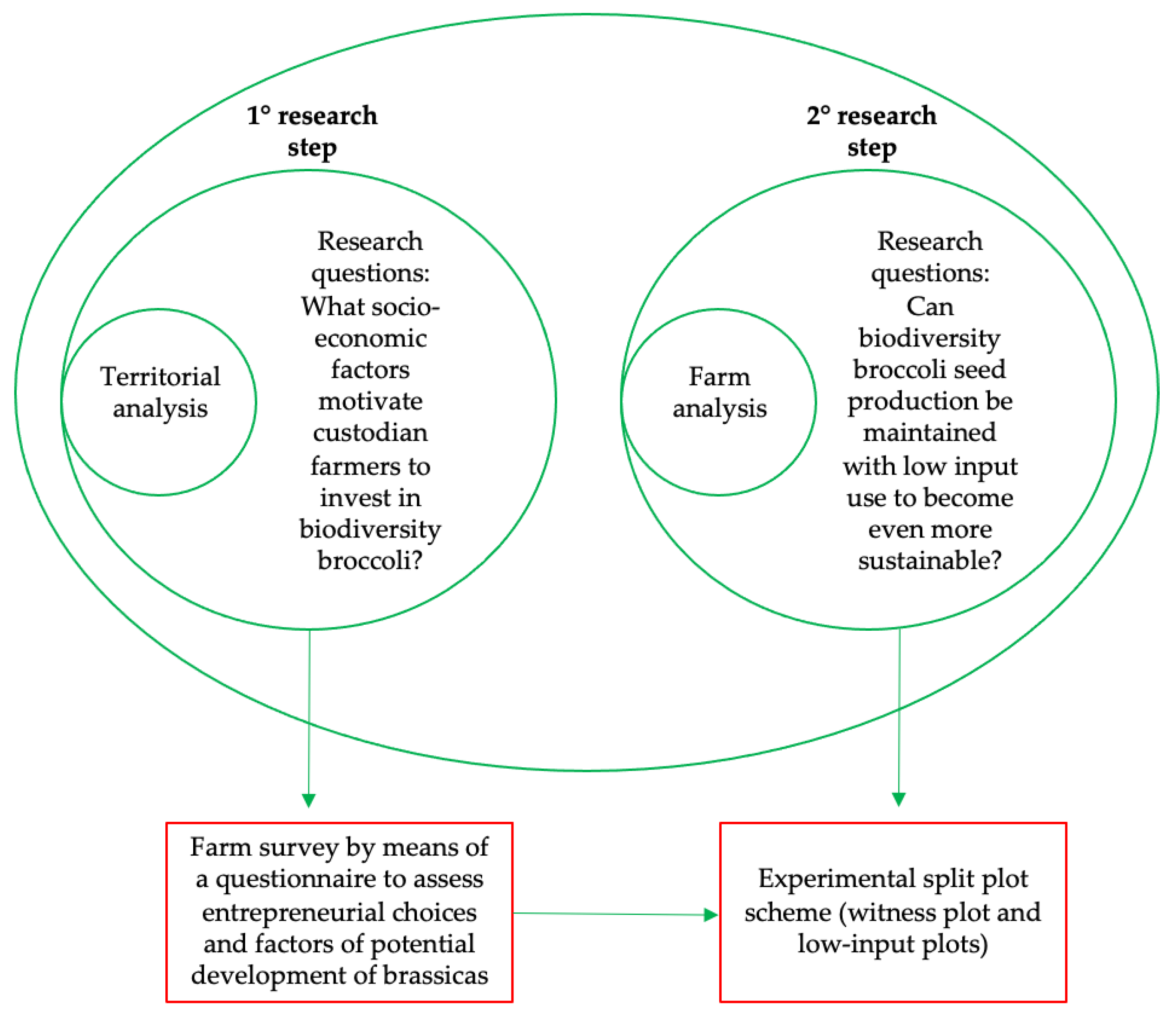
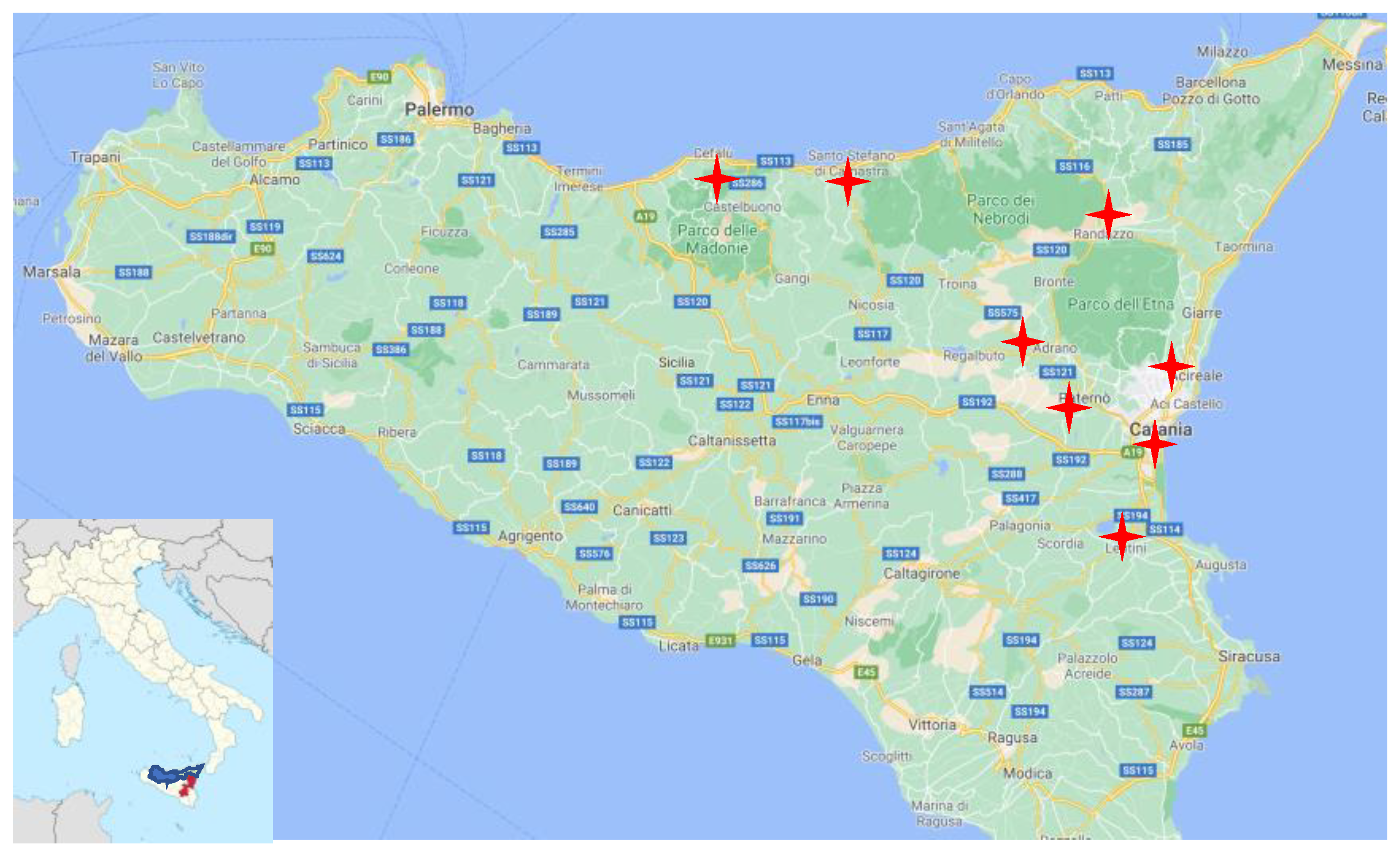
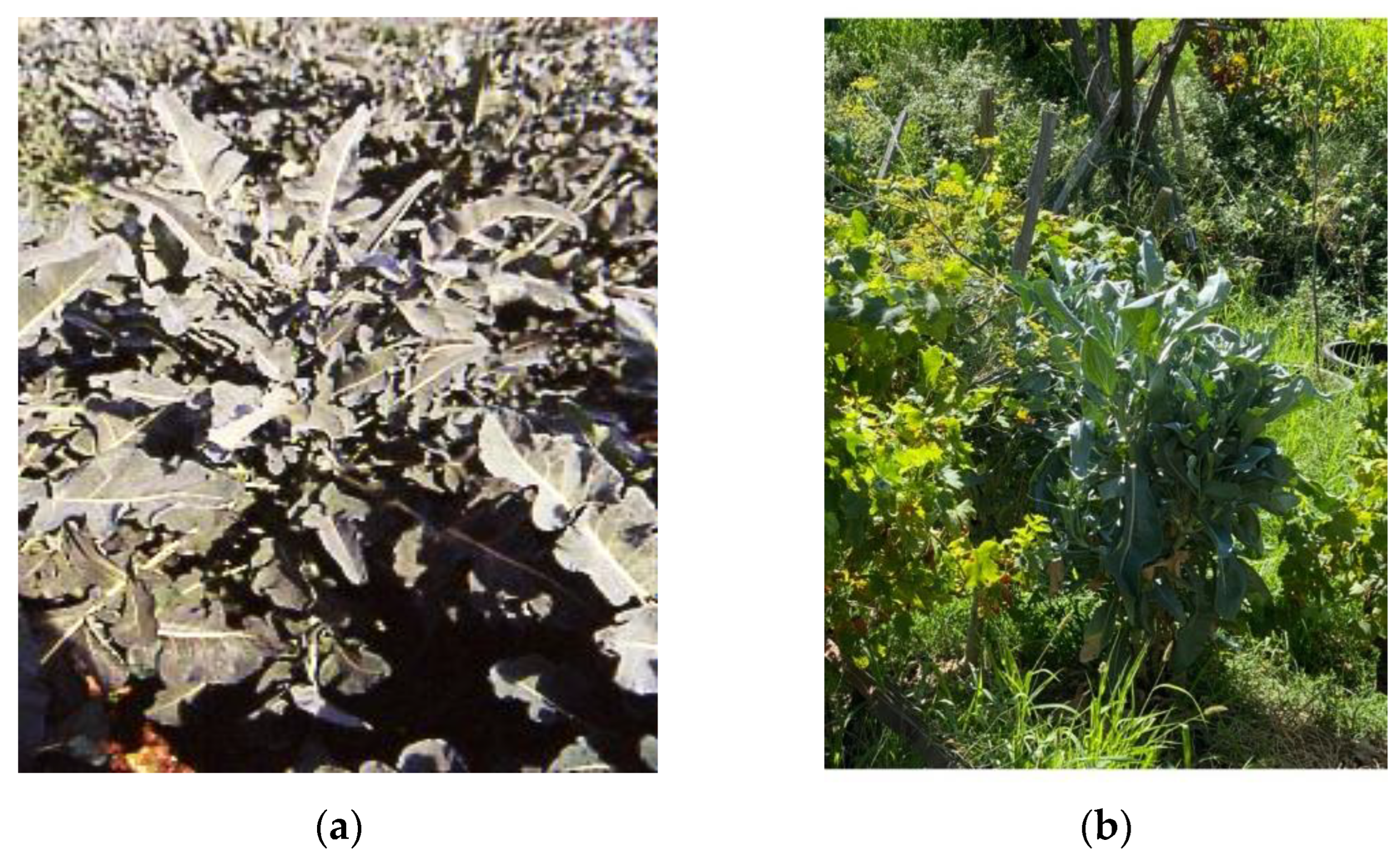
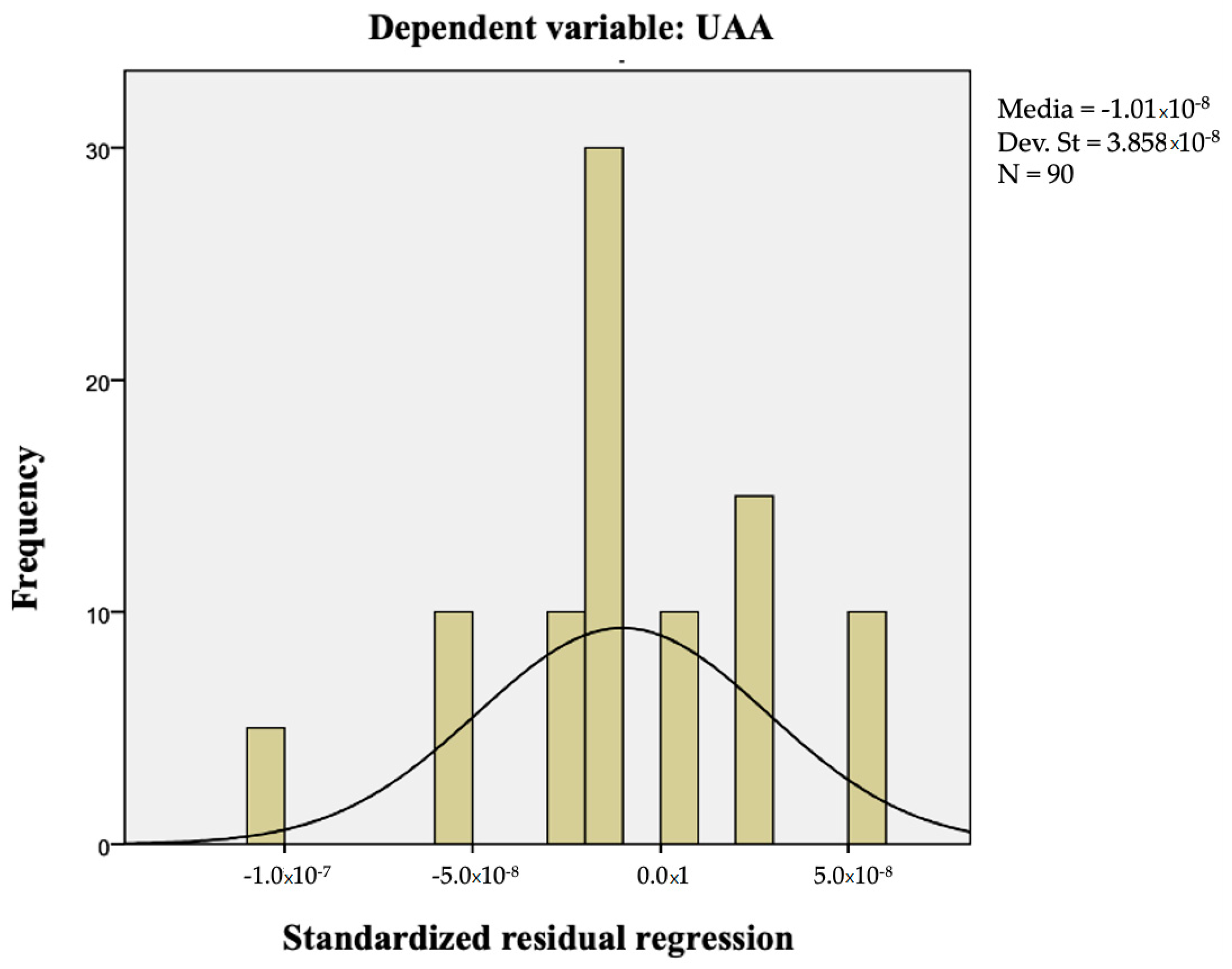
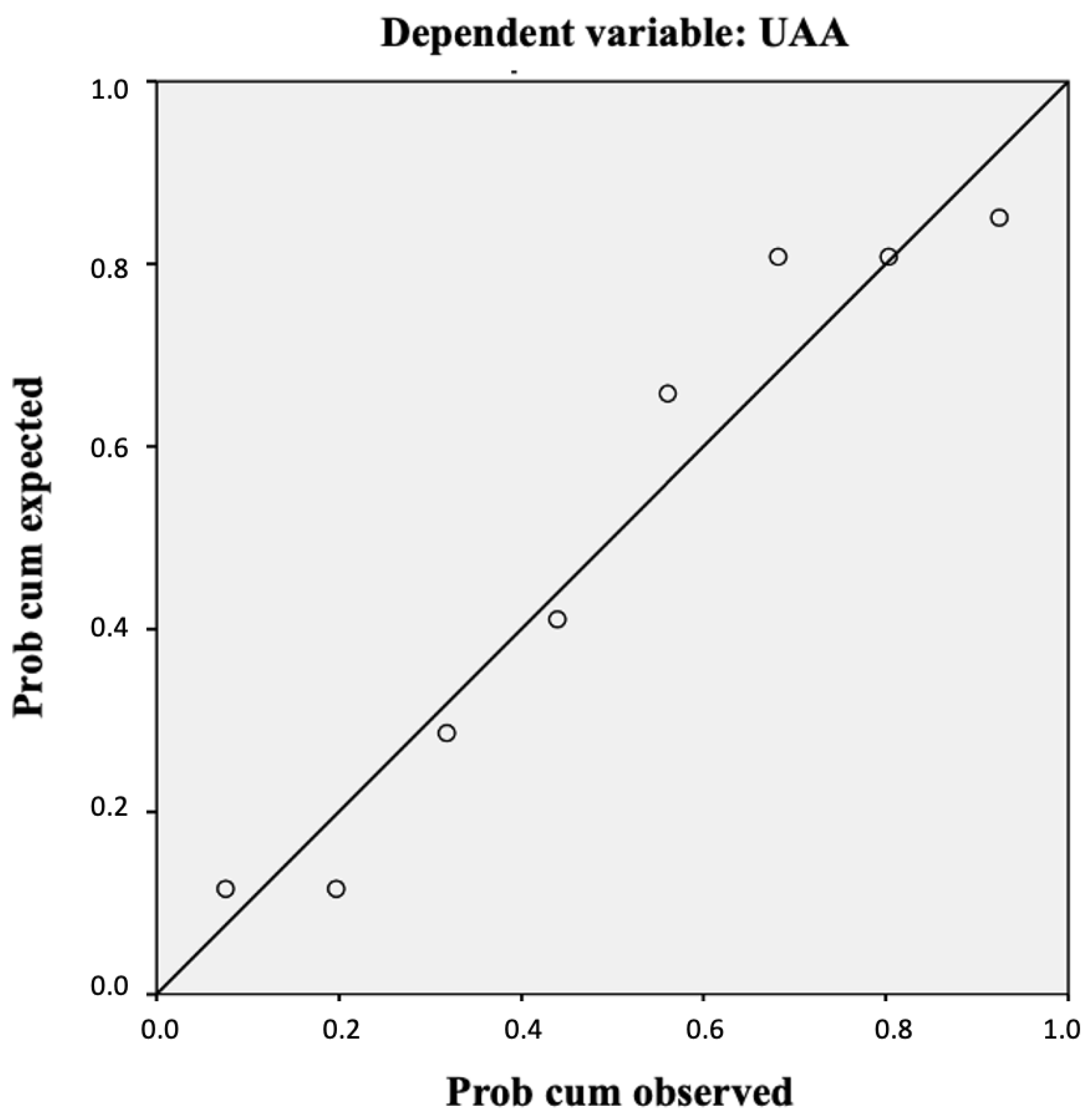


| Variable | Acronym | Measuring Level |
|---|---|---|
| Type of regime | REGIME | Certified organic = 1; Integrated farming = 2; Conventional with good agricultural practices = 3; Conventional = 4 |
| Age | AGE | Under 35 years = 1; Between 35 to 60 = 2; Over 60 years = 3 |
| Accessibility to the informal seed market | SEED_MARK | yes = 1; no = 0 |
| Implementation of agricultural practices to promote the biodiversity of the cultivation environment | BIOD_ENVIR | yes = 1; no = 0 |
| Types of activity | BIOD_ENVIR_ACT | Composting = 1; Green manure = 2; Feeding troughs for wild animals = 3; Bird houses = 4; Hedge maintenance = 5; Wildflower maintenance and pollinator development = 6; Dry stone walls = 7; Care of damaged trees = 8; Wide mesh netting for wildlife mobility = 9 |
| Using biodiversity to attract customers/consumers | ATTRAC_CUST_CONS | yes = 1; no = 0 |
| Importance of biodiversity for attracting customers/consumers | MARKET | From 1 = low to 5 = high |
| Using natural farm features to promote the biodiversity market | NAT_ASPECT | yes = 1; no = 0 |
| Importance of natural business aspects | NAT_ASPECT_MARKET | From 1 = low to 5 = high |
| Biodiversity supply chain | SUPPLY_CHAIN | yes = 1; no = 0 |
| Farm location in Natura 2000 Network Site (SIC/ZPS) | NATURA_2000 | yes = 1; no = 0 |
| Role of sustainability in the territory | SUST_TERR | From 1 = low to 5 = high |
| Influence on landscape | LANDSCAPE | From 1 = low to 5 = high |
| Pollution of conventional agriculture | POLLUT_CONV | From 1 = low to 5 = high |
| Ecosystem improvement with organic farming | ECOSYS_ORGANIC | From 1 = low to 5 = high |
| Crop profitability | PROFIT | From 1 = low to 5 = high |
| Hydrogeological system influence | HYDROG_SYST | From 1 = low to 5 = high |
| Ability to maintain biodiversity | BIODIVERS_ABILIT | From 1 = low to 5 = high |
| Productive address | PROD_ADDRESS | Specialised horticulture = 1; Mixed horticulture = 2; Horticulture and fruit growing = 3 |
| Cultivated Biodiversity Brassica | BRASSIC_CROP | Brassica oleracea var. italica “Sparacello” = 1; Brassica oleracea var. acephala “Riccio” = 2; Brassica oleracea var. italica “Natalino” = 3 |
| (*) Our elaborations. |
| Nutrition Protocols | ||||
|---|---|---|---|---|
| Thesis | Product | Doses (Kg/Ha) | N Supplied/Ha | Notes |
| NP0 | None | None | None | None |
| 3KO © | 5 | -- | Every two weeks | |
| Amminocomplex extra © | 80 | 6.4 kg | Every two weeks | |
| 3KO © | 10 | -- | Every two weeks | |
| Amminocomplex extra © | 160 | 12.8 kg | Every two weeks | |
| Variables | Value | Variables | Value |
|---|---|---|---|
| Utilised Agricultural Area (UAA), % | Age of the entrepreneur, % | ||
| Up to 3 hectares | 37.5 | Under 35 years | 25.0 |
| From 3 ha to 10 ha | 50.0 | Between 35 to 60 years | 62.5 |
| Over 10 hectares | 12.5 | Over 60 years | 12.5 |
| Cultivated Biodiversity Brassica, % | Cultivation practices in favour of the environment and biodiversity, % | ||
| Brassica oleracea var. italica “Sparacello” | 37.5 | Composting | 16.7 |
| Brassica oleracea var. acephala “Riccio” | 37.5 | Green manure | 5.6 |
| Brassica oleracea var. italica “Natalino” | 25.0 | Feeding troughs for wild animals | 22.2 |
| Bird houses | 11.1 | ||
| Productive address, % | Hedge maintenance | 5.6 | |
| Specialised horticulture | 50.0 | Wildflower maintenance and pollinator development | 11.1 |
| Mixed horticulture | 37.5 | Dry stone walls | 5.6 |
| Horticulture and fruit growing | 12.5 | Care of damaged trees | 16.7 |
| Wide mesh netting for wildlife mobility | 5.6 | ||
| Regime, % | |||
| Certified organic | 25.0 | Farm location in Natura 2000 Network Site (SIC/ZPS), % | |
| Integrated farming | 37.5 | Yes | 50.0 |
| Conventional with good agricultural practices | 25.0 | No | 50.0 |
| Conventional | 12.5 | ||
| Market accessibility of biodiversity seeds, % | |||
| Self-production | 75.0 | ||
| Informal market | 25.0 | ||
| (*) Our elaborations. |
| Summary of the Model | |||||||
|---|---|---|---|---|---|---|---|
| Variation of Adaptation | |||||||
| Model | R-statistics | R-square | Corrected R-square | Standard deviation Error of prediction | Variation of F | Significance Change in F | Durbin-Watson |
| 1 | 0.717 a | 0.614 | 0.534 | 0.697 | 6.357 | 0.045 | 2.600 |
| ANOVA a | |||||||
| Model | Sum of squares | df | Mean of squares | F | Sig. | ||
| Regression | 48.889 | 7 | 6.984 | . | 0.0000 b | ||
| Residue | 0.000 | 82 | 0.000 | ||||
| Total | 48.889 | 89 | |||||
| Coefficients | |||||||
| Model | Coefficients | Standard error | T-Stat | Significance value | |||
| (Constant) | 0.407 | 0.000 | 27,852,210.1 | 0.000 | |||
| CROP | 0.203 | 0.000 | 58,788,023.199 | 0.000 | |||
| PROFIT | 0.441 | 0.000 | 75,379,260.543 | 0.000 | |||
| BIOD_ENVIR_ACT | −0.008 | 0.000 | −5,180,378.917 | 0.000 | |||
| HYDROG_SYST | 0.975 | 0.000 | 104,030,143.276 | 0.000 | |||
| NAT_ASPECT | −1.11 | 0.000 | −165,986,518.483 | 0.000 | |||
| PROD_ADDRESS | 0.127 | 0.000 | 35,806,966.104 | 0.000 | |||
| MARKET | 0.169 | 0.000 | 64,933,983.30 | 0.000 | |||
| SEED_MARK | −0.737 | 0.000 | −116,750,453.488 | 0.000 | |||
| (*) Our elaboration. | |||||||
| NP0 | NP1 | NP2 | Mean | |
|---|---|---|---|---|
| Riccio di Messina | 626.9 | 742.8 | 1571.0 | 980.2 |
| Sparaceddu | 276.3 | 962.2 | 1087.0 | 775.1 |
| Mean | 451.6 | 852.5 | 1329.0 |
| Nutrition Protocols | NP0 | NP1 | NP2 | Mean | |||||||
|---|---|---|---|---|---|---|---|---|---|---|---|
| Characteristics | SP | CR | Mean | SP | CR | Mean | SP | CR | Mean | SP | CR |
| Total weight(g) | 134.4 | 30.6 | 82.5 | 175.3 | 41.8 | 129.5 | 310.7 | 76.7 | 193.8 | 139.4 | 59.3 |
| Stem height(g) | 20.0 | 13.7 | 16.9 | 18.3 | 7.0 | 12.7 | 20.7 | 15.3 | 18.0 | 19.7 | 12.0 |
| Collar diameter (mm) | 14.1 | 6.3 | 10.2 | 15.5 | 6.3 | 10.9 | 20.3 | 8.4 | 14.4 | 16.6 | 7.0 |
| Branches (n) | 3.0 | 2.3 | 2.7 | 3.3 | 3.5 | 3.4 | 3.3 | 3.0 | 3.2 | 3.2 | 2.9 |
| Total Weight (g) | Stem Height (g) | Collar Diameter (mm) | Branches (n) | ||||||||
| Nutrition protocol (NP) | *** | n.s. | *** | n.s. | |||||||
| Genotype (GE) | *** | ** | *** | *** | |||||||
| Interaction NP × GE | *** | n.s. | n.s. | n.s. | |||||||
| NP0 | NP1 | NP2 | |
|---|---|---|---|
| Materials: | 2.100 | 3.000 | 3.900 |
| —of which expenditure for fertilizers | 0.0 | 900 | 1.800 |
| Labor and services: | 3.670 | 4.320 | 4.970 |
| —of which expenditure for fertilizer administration | 0.0 | 650 | 1.300 |
| Quotas and other attributes | 420 | 420 | 420 |
| Total average cost | 6.190 | 7.740 | 9.290 |
| % variation | −33.37 | −0.17 | 0.0 |
| Seed yield g m2 | 451.6 | 852.0 | 1.329 |
| % variation | −66.02 | −0.36 | 0.0 |
| (*) Our elaboration. |
Publisher’s Note: MDPI stays neutral with regard to jurisdictional claims in published maps and institutional affiliations. |
© 2022 by the authors. Licensee MDPI, Basel, Switzerland. This article is an open access article distributed under the terms and conditions of the Creative Commons Attribution (CC BY) license (https://creativecommons.org/licenses/by/4.0/).
Share and Cite
Timpanaro, G.; Branca, F.; Cammarata, M.; Di Bella, M.C.; Foti, V.T.; Scuderi, A. Biodiversity Enhancement for Improving the Sustainability of Broccoli (Brassica oleracea vr. italica Plenk) Organic Seed Production. Sustainability 2022, 14, 6417. https://doi.org/10.3390/su14116417
Timpanaro G, Branca F, Cammarata M, Di Bella MC, Foti VT, Scuderi A. Biodiversity Enhancement for Improving the Sustainability of Broccoli (Brassica oleracea vr. italica Plenk) Organic Seed Production. Sustainability. 2022; 14(11):6417. https://doi.org/10.3390/su14116417
Chicago/Turabian StyleTimpanaro, Giuseppe, Ferdinando Branca, Mariarita Cammarata, Maria Concetta Di Bella, Vera Teresa Foti, and Alessandro Scuderi. 2022. "Biodiversity Enhancement for Improving the Sustainability of Broccoli (Brassica oleracea vr. italica Plenk) Organic Seed Production" Sustainability 14, no. 11: 6417. https://doi.org/10.3390/su14116417
APA StyleTimpanaro, G., Branca, F., Cammarata, M., Di Bella, M. C., Foti, V. T., & Scuderi, A. (2022). Biodiversity Enhancement for Improving the Sustainability of Broccoli (Brassica oleracea vr. italica Plenk) Organic Seed Production. Sustainability, 14(11), 6417. https://doi.org/10.3390/su14116417










